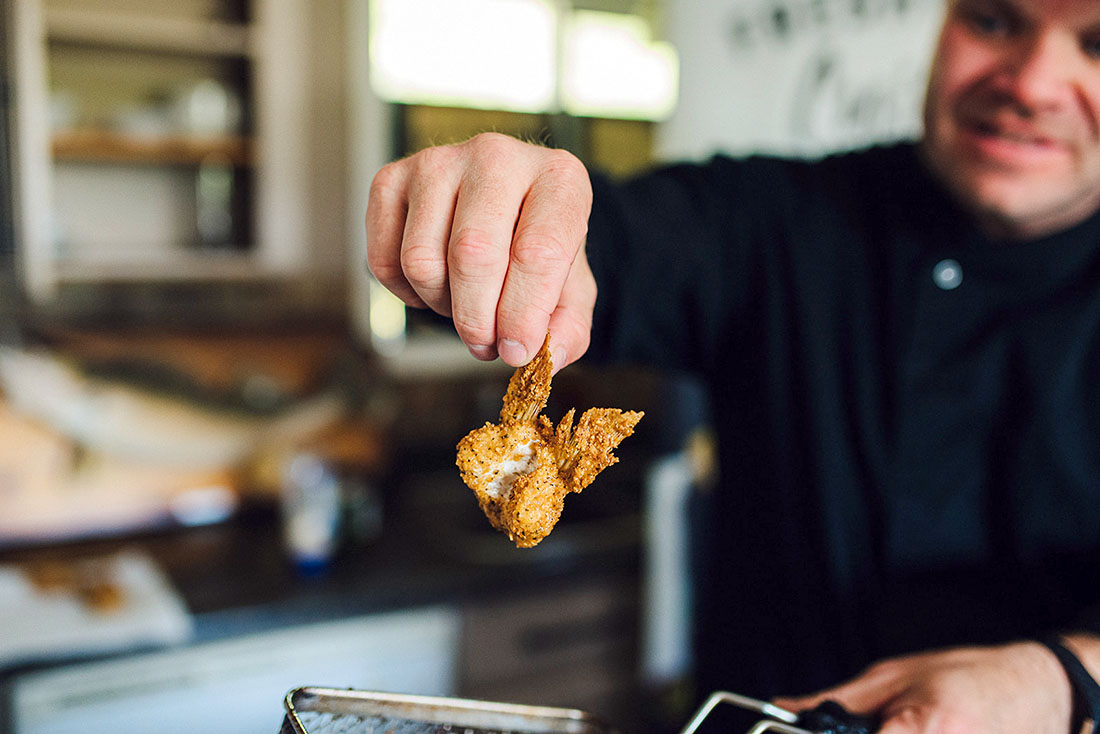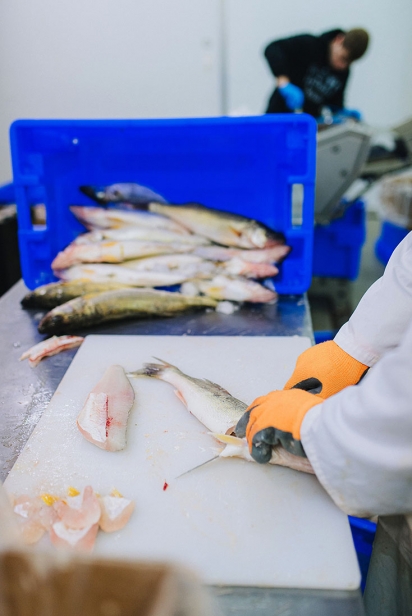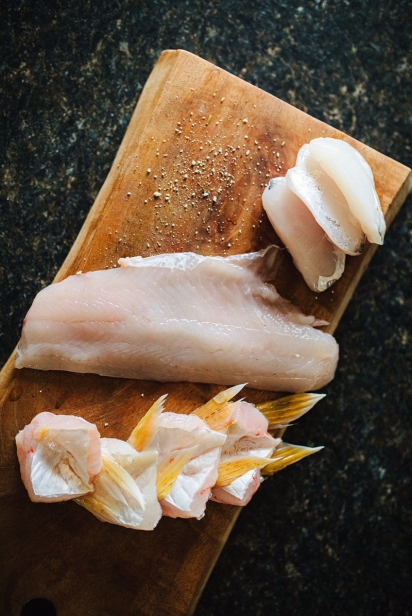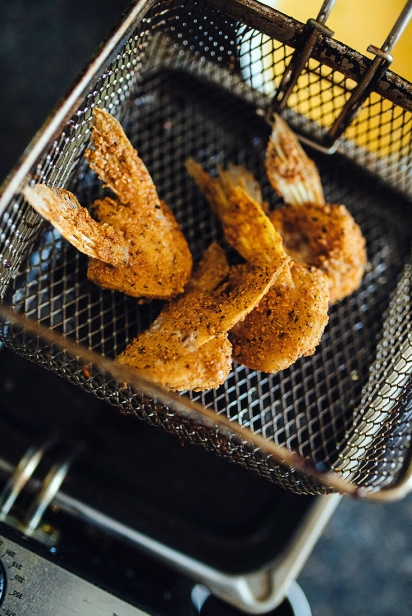There's a New Wing in Town
Kenora chef Jay Barnard adores unloved fish — every last bit and bone of them. Northern Ontario lake fish, edged out by more popular and accessible salmon and cod at the grocery store and on restaurant menus, are a passion for Barnard, CEO and corporate chef at Freshwater Cuisine.
It’s part of 39-year-old Barnard’s push to minimize food waste while promoting snout-to-tail eating — with fins. He’s fond of calling it his mission and when you talk to the enthusiastic entrepreneur, he’s clearly on more than one.
Take the fleshy pectoral area of a sweet-tasting walleye. Located under the fish’s chin, with two fins on either side to serve as handles for easy eating or dipping, the meaty delicacy is something northern anglers have long known about, whether for eating or as bait.
Barnard likens the texture and neutral flavour of this “phenomenal piece of meat” to the small fillets on a boned chicken breast.
“You hold the fin and you can dip it in sauces. Your fingers don’t get dirty. You chew around the bone and eat the meat,” he says. “They’re so versatile. You can poach, grill, deep-fry, bake or smoke them.”
Move over Buffalo. There’s a new wing in town: Walleye Wings.
“Nobody ever took that piece of meat and brought it to the commercial market,” says Barnard (no relation to this writer), who has copyrighted the Walleye Wing name with the Canadian government and is busy promoting the dish. Walleye Wings are on the menu in several pub-style restaurants in Northwestern Ontario and Manitoba.
Barnard is convinced if consumers could ditch their fish fillet kick, they’d find some delicious eating and help sustainability in the process. On average, only 44 per cent of the whole fish is used, he says. That’s 56 per cent wasted, mostly in the pursuit of trim fillets.
“That’s all people were doing. They were taking off the fillets and all of that carcass was left behind,” he says.
Barnard sees opportunity everywhere, including sharing stories of his struggles with drugs and alcohol.
He calls himself Chef Recovery, a mental-health advocate who talks openly about starting drinking at age 12 as kid growing up in Kenora, selling drugs, his addictions, incarceration and suicide attempts.
“I think my mission is to go out and share my story of recovery and my ups and downs and be open and honest every day,” he says of his public speaking and Chef Recovery social media profile. “I was telling my story wherever I could.”
Looking for help with his addictions led him to a Salvation Army program in Ottawa, followed by classes at Algonquin College and a new vocation as a chef.
Barnard returned to his hometown of Kenora in 2015 as executive chef at a newly opened restaurant The Boathouse, making sure local and wild-caught freshwater fish got the star treatment on the menu.
“I didn’t see salmon and cod when we were on Lake of the Woods,” a body of water that straddles Ontario, Manitoba and Minnesota, so “why would we have that?” Barnard asks.
He experimented with Walleye Wings, taking them beyond a breaded-and-fried bar snack. The restaurant also offered them as a salad add-on or a topping for a steak, for a freshwater lake and turf combo.
Then a Kenora fish plant came on the market. Walleye Wings were about to soar. Barnard got a mortgage and bought the business and building in 2016, naming the company Freshwater Cuisine.
He now works with dozens of local Indigenous fishers to buy their wild-caught catches, including yellow perch, walleye and black crappie. Barnard also buys from Manitoba fishers.
Freshwater employs 14 people in the summer season and is the largest fish-processing facility in Northwestern Ontario. It processes and flash-freezes a variety of items, including pickerel cheeks, Walleye Wings and fillets and ships across Northern Ontario and Manitoba, along with direct sales at the plant to local customers.
In 2017, the company won the Premier’s Award for Agri-Food Innovation Excellence.
The Walleye Wings, cut from fish weighing two pounds and up, used to be seasoned and breaded before freezing, but that turned out to be a production headache. Freshwater Cuisine now freezes them naked, at 19 to 21 wings per pound. The same thing went for the pickerel cheeks, which are also frozen without breading. Fishcakes made from flaked whitefish and Northern pike are also being reinvented.
Recent deals with foodservice distributors Sysco and Gordon Food Service will get Freshwater Cuisine products across Canada, Barnard says.
He’s confident there’s a market. At the RC foodservice show in Toronto this year, he went through 1,000 pounds of Walleye Wings. “The trendy word is health,” Barnard says. “Fish is healthy.”
Properly processed fish is also healthy for the planet. One walleye carcass can provide seven different items, from stock to cheeks, he says. He’s working on a freshwater fish version of Clamato-style drink made with local tomatoes to make a Northwestern Ontario Caesar with Ontario- distilled vodka.
Barnard is also experimenting with dry-freezing whitefish eggs, adding different flavours to make a salty topping to shake on foods such as eggs and pizza. Think of it as the local version of bottarga, the Italian delicacy of salted and cured fish roe, or karasumi, the Japanese version of cured roe, which runs on the softer side.
“How can I think of a way to eat 100 per cent of the raw natural resource and maybe put that back into the earth via a liquid fish fertilizer?” he says, always pushing his no-waste mantra.
Three years of organic fish fertilizer studies, including one with Lakehead University in Thunder Bay, Ont., showed crops grew faster and stronger with its use, resulting in healthier soil over time.
He’s eager to find an investor to help him open a fertilizer plant for the fish bones and remains.
Barnard also came up with ideas for cartoons to give the products a consumer-friendly identity, such as the tuxedo- wearing “spokesfish” for Walleye Wings, designed by Alberta tattoo artist Chris Ryerson.
He also does an enthusiastically ragtag, unscripted YouTube video cooking show called Lake to Plate that airs on the local cable station.
“In my life, I looked at myself as unutilized, undervalued and unappreciated and that’s how people looked at freshwater fish,” Barnard says. “So, I took my life and my business and put it together.”
Freshwater Cuisine
18 Sunnyside Rd., Kenora, Ont.
freshwatercuisine.com | 807.543.6565 | @freshwatercuisine










